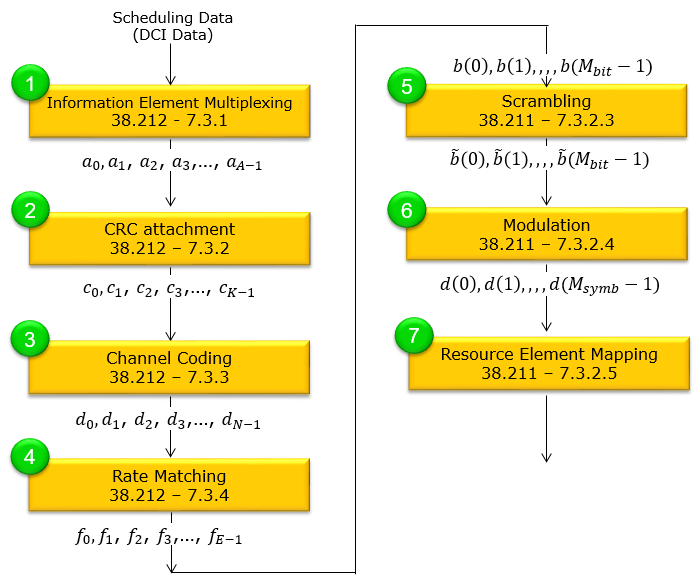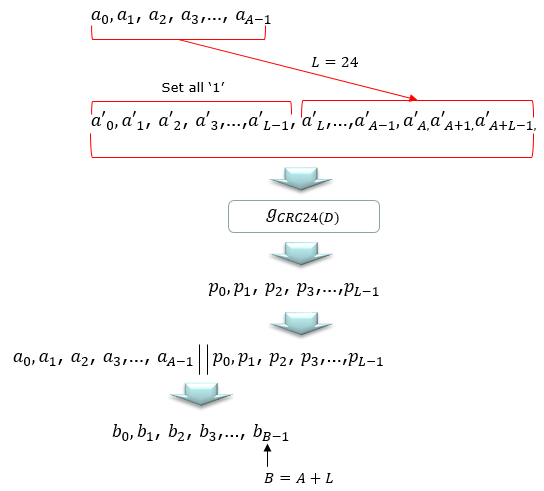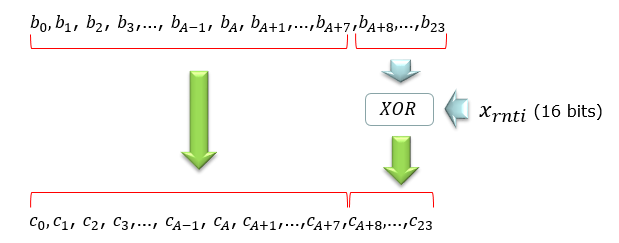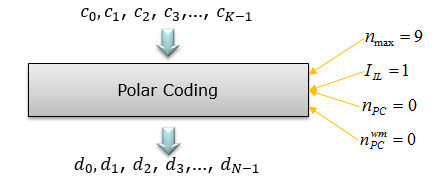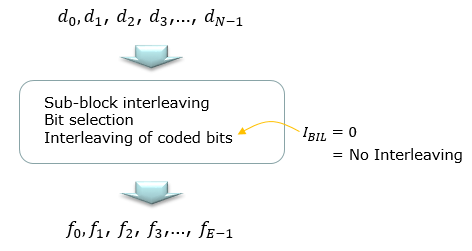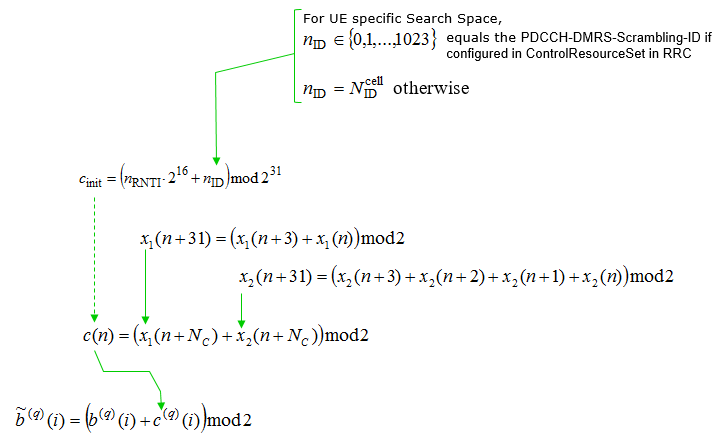|
|
||
|
As in LTE, NR PDCCH is the physical channel that carries DCI and this would be one of the most important channel which is supposed to be very robust and easily decoded even in harsh radio condition. Overall channel coding and physical layer process is also similar to LTE PDCCH as listed below with a few differences like channel coding.
PDCCH Transport ProcessFollowing diagram illustrates the PDCCH Transport Process in a cellular communication system, detailing the sequence of steps involved in preparing and transmitting the PDCCH from gNB to UE
(1) Information Element MultiplexingThis is a process of generating a bit string of DCI carrying various control and scheduling information. Refer to DCI page to see the details of the contents. If the size of DCI is less than 12 bit, it will be zero padded until it become 12 bits (Ref [1]).
(2) CRC Attachment
Following diagram illustrates the CRC Attachment process for the 5G PDCCH (Physical Downlink Control Channel). As you see here, 24 bits CRC is appeded to DCI data.
Initially, DCI (Downlink Control Information) data is presented as a sequence of bits a0, a1, a2, ..., aA-1. A 24-bit CRC is appended to this DCI data. To prepare for CRC attachment, a sequence is extended by setting all bits following the DCI data to '1' for a length L of 24, resulting in an extended sequence a'0, a'1, a'2, ..., a'L-1, a'L, ..., a'A+L-1. This sequence is processed using a generator polynomial GCRC24(D), producing a CRC of bits p0, p1, p2, ..., pL-1. The DCI data and CRC are then concatenated, forming a complete sequence a0, a1, a2, ..., aA-1 | p0, p1, p2, ..., pL-1, which is denoted by b0, b1, b2, ..., bB-1. The total length of the sequence after CRC attachment is B = A + L. This CRC attachment process is a crucial step in ensuring the integrity of the control information as it allows the receiver to detect any errors that may have occurred during the transmission.
After CRC Attach, the last 16 bit is masked with a specific RNTI. Using this RNTI, UE figures out which UE the DCI is for and what is the usage of the DCI.
After the CRC is appended to the DCI data, resulting in the sequence b0, b1, b2, ..., bA-1, bA, ..., b23, the last 16 bits are masked with a specific RNTI (Radio Network Temporary Identifier). This masking is performed by XORing the last 16 bits of the sequence with the 16-bit RNTI, denoted as xRNTI. The RNTI is a unique identifier that enables the User Equipment (UE) to determine which DCI is intended for it and understand the usage of the DCI. The output of this process is a new sequence c0, c1, c2, ..., cA-1, cA,...,cA+7,cA+B, ..., c23, where the last 16 bits have been modified by the RNTI masking. This step is crucial for directing the DCI to the correct UE and for protecting the information's integrity.
After RNTI masking, the data is interleaved so that CRC bits are distributed among information bits. This interleaver supports a max input size of 164 bits meaning that DCI without CRC can be max 140 bits.(Ref [1])
(3) Channel CodingThe image shows the Channel Coding step, which is part of the PDCCH channel coding processing.
In this step, the sequence c0, c1, c2, ..., cK-1 undergoes Polar Coding, a method known for its efficiency in error correction capabilities. The Polar Coding process is characterized by several parameters: nmax represents the maximum number of reliable sequence indices and is set to 9; IIL denotes the list size used in decoding, given as 1; npc is the number of parity check bits, which is 0 in this case; and npcwm is another parity check parameter, also set to 0 here. After Polar Coding, the data sequence is transformed into d0, d1, d2, ..., dN-1, which is ready for subsequent transmission steps. This coded sequence is more resistant to errors during transmission over the communication channel. (4) Rate MatchingThis diagram illustrates the Rate Matching step in PDCCH channel processing, which is essential for adapting the coded data to the correct size for transmission.
Starting with the coded data sequence d0, d1, d2, ..., dN-1, the process involves sub-block interleaving and bit selection. Interleaving of coded bits is indicated, but with IBIL set to 0, this implies that there is no interleaving applied to the data. Following this, the data sequence is adjusted to match the transmission rate, resulting in a new sequence f0, f1, f2, ..., fE-1. This rate matching process ensures that the data fits into the allocated transmission resources and is correctly received and decoded by the User Equipment. (5) ScramblingThe image illustrates the scrambling process, which is essential for ensuring data integrity and security.
The scrambling process uses an initialization sequence cinit that is derived from the RNTI (Radio Network Temporary Identifier) and an identifier nID. For UE specific search spaces, nID is set to a value defined by the PDCCH-DMRS-Scrambling-ID if configured in ControlResourceSet in the RRC (Radio Resource Control) layer, which can range from 0 to 1023. Otherwise, nID equals NIDcell, the physical cell ID. The initialization sequence is calculated as cinit = (RNTI * 216 + nID) mod 231. Two sequences x1(n) and x2(n) are generated and used to produce the scrambling sequence c(n) through a defined polynomial relationship. Finally, the data bits b(i) are scrambled with c(n) to produce the scrambled bits b~(i) = (b(i) + c(i)) mod 2. This scrambled sequence is more resistant to interference and unauthorized interception, enhancing the overall security and reliability of the communication. (6) ModulationFollowing figure depicts the modulation process for PDCCH.
The process starts with a binary sequence represented as b~(0), b~(1), ..., b~(Mbit - 1). This sequence undergoes Quadrature Phase Shift Keying (QPSK) modulation, which is a method that maps every two bits of the binary sequence to one symbol, represented as a complex number. Thus, two binary bits are converted into a single QPSK symbol. After modulation, the sequence of binary bits is transformed into a sequence of complex numbers, d(0), d(1), ..., d(Msymb - 1), where each symbol in this new sequence corresponds to a pair of binary bits from the original sequence. The result of this modulation is a complex number sequence suitable for transmission over the radio frequency spectrum. (7) Resource Element MappingThis is putting the ecoded and modulated PDCCH bits into each resource elements in NR resource grid. The gNB should assume a block of complex-valued symbols d(0), ..., d(Msymb - 1) is to be scaled by a factor βPDCCH and then mapped to resource elements (k, l)p, u that are designated for the monitored PDCCH and not used for the associated PDCCH DMRS. The mapping order should follow an increasing sequence of first k, then l. The specified antenna port for this operation is p = 2000. The process can be described in step by step as follows:
Through these steps, the gNB systematically assigns the PDCCH symbols to the appropriate resources on the frequency-time grid for effective transmission. RRC ParametersPDCCH-Config ::= SEQUENCE { controlResourceSetToAddModList SEQUENCE(SIZE (1..3)) OF ControlResourceSet OPTIONAL, controlResourceSetToReleaseList SEQUENCE(SIZE (1..3)) OF ControlResourceSetId OPTIONAL, searchSpacesToAddModList SEQUENCE(SIZE (1..10)) OF SearchSpace OPTIONAL, searchSpacesToReleaseList SEQUENCE(SIZE (1..10)) OF SearchSpaceId OPTIONAL, downlinkPreemption SetupRelease { DownlinkPreemption } OPTIONAL, slotFormatIndicator SetupRelease { SlotFormatIndicator } OPTIONAL, tpc-PUSCH SetupRelease { PUSCH-TPC-CommandConfig } OPTIONAL, tpc-PUCCH SetupRelease { PUCCH-TPC-CommandConfig } OPTIONAL, ... }
Reference[1] Understanding the Heart of the 5G Air Interface: An Overview of Physical Downlink Control Channel for 5G New Radio (NR) - by Kazuki Takeda, Huilin Xu, Taehyoung Kim, Karol Schober∧, and Xingqin Lin# Qualcomm Inc., Samsung Electronics,∧Nokia, #Ericsson Inc.
|
||
